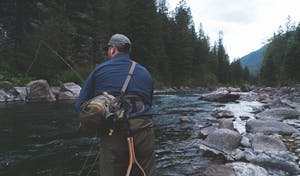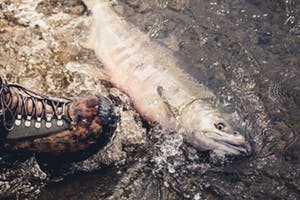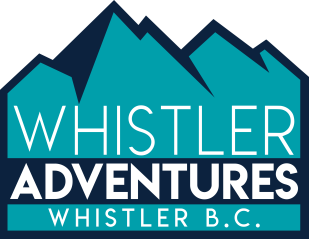Chinook, Coho and Sockeye | Oh My! Fish for Salmon in Whistler

When someone mentions Whistler, what comes to mind? Powder turns, endless ski terrain, a vibrant apres scene, and a world-class bike park would all be common answers. But did you know that this valley in British Columbia is also a salmon fishing mecca? As the seasons change, so do the types of catch and the best places to go in search of them. Salmon fishing in British Columbia is a big deal and Whistler is one of the province’s top fly-fishing destinations.

Fishing in the waters around Whistler, gets you off the hill and into the water
With its secluded alpine lakes, icy mountain streams and easy access to warmer coastal rivers, there’s a huge variety of accessible fishing spots. As you drive from Vancouver to Whistler, along the Sea to Sky Highway, you’ll see how the landscape dramatically changes. Every fall, adult salmon make extraordinary migrations along this coast to alpine corridor, fighting their way upstream from the ocean, back to the higher-elevation rivers in which they were born.
BC’s waters become flooded with the province’s iconic animal. Leaping their way through waterfalls and rapids, trying to avoid becoming prey to bears or bald eagles, the mighty fish that finally reach their spawning grounds lay thousands of eggs, and then die. This epic spectacle is known as the salmon run and it’s a spectacular time to witness and fish for salmon. When this happens, you have to try a Whistler fly fishing experience.
So if you’re hooked on fishing, read on to discover how to get the most out of this sport in the Whistler area.
When and Where to Find Salmon Around Whistler

You’d be surprised what lays in store for you in the waters around Whistler
You can try your hand at fly-fishing in many of Whistler’s lakes, including the glacial-fed and extremely cold Green Lake, which appears a stunning emerald colour in the summertime. Or why not head to the more intimate, alpine Showh Lakes, or the centrally-located Lost Lake and Alta Lake.
But if it’s salmon that you’re primarily after, your best bet is to drive a little further afield. The Cheakamus River, the Mamquam River and the famous Squamish River are fantastic salmon bearing systems and all within an hour drive of Whistler. Multiple species of salmon return to these rivers each fall, so there are plenty of excellent recreational fishing opportunities.
Wondering when’s best to fish?
- May: In early May, Chinook salmon begin their journey into freshwater.
- June: If you’re looking to hook one of these wild beasts, the month of June is your greatest chance.
- August to October: If Sockeye is your target fish, your window months are from August to October.
- August to September: On odd years, you’d be a fool not to check out the summer run of Pink salmon, where thousands of these animals can be seen fighting their way back to their natal rivers. It really is a spectacular natural wonder and the prime time to witness it is early August to late September.
- October to November: Whilst if you’re aiming to catch a Coho salmon go fishing in October and November.
Get the Know the Salmon Around Whistler
Coho, Chinook, Chum, Pink and Sockeye are the five species of Pacific salmon commonly found in the waters of British Columbia. They might look similar in appearance but dig a little deeper and they’re all distinct. Before you head out on a whistler fly fishing adventure – learn a little more about these amazing creatures.
Chinook Salmon – The King
- Also known as the King salmon, Chinook is the patriarch of this fish family. They are the largest of the Pacific salmon species – most weigh in at around 30 pounds but the world record catch stands at a whopping 126 pounds!
- Once fully grown, they reach 40 to 60 inches long.
- Amazingly, they have exactly the same number of scales as Pink salmon, despite Pink salmon being the smallest of all five species.
- They travel great distances and can migrate up to 1500 kilometres inland, making phenomenal leaps out of the water as they swim.
- They have a long life-cycle of three to seven years, meaning that they remain in the ocean for much longer than others of their species before returning to where they were born.
- They are a favourite meal of Southern Resident killer whales.
Coho Salmon – The Acrobat

What local Whistler salmon species is on your bucket list?
- These fish are extremely gluttonous and grow quickly, reaching between eight and 12 pounds at their heaviest.
- Unlike other Pacific salmon that generally migrate far on their life journey, Coho remain in coastal waters.
- If you see these fish convulsing their bodies into odd shapes what you’ll be witnessing is a display to defend their territory, known as the ‘wig-wag’ dance.
- Known for their acrobatic displays and their ability to leap both up and sideways, they are a welcome challenge for sport fishers, and a highly-prized catch.
Sockeye Salmon – The Beauty Queen
- These fish have long been a dominant symbol among Indigenous communities, and a valued source of nutrition.
- The delectable taste of this salmon puts it at the top of the list in the opinion of many diners, and they are the most commercially sought after Pacific salmon for their superior quality.
- The flesh of these fish can be a striking blood-red.
- Sockeye typically mature at four years old, and at this time they can be anywhere between five and 12 pounds.
- These fish love lakes. They spend up to three years in freshwater after birth before heading to the ocean.
Chum Salmon – The Underdog
- Second to the Chinook in terms of size is the Chum salmon, weighing in between eight and 15 pounds.
- The large males of this species can be seen sporting huge, canine-like teeth, giving them the nickname of Dog salmon. Another theory goes that this nickname comes from the fact that Indigenous communities use these fish for dog food.
- They are a strong, aggressive fish, famed for their fighting behaviour, that travel in schools as they approach spawning time.
- Unlike the Chinook, these fish aren’t strong jumpers. Even a small waterfall can hinder their migration.
- Although the least sought-after of the salmon species, fishing for Chum is a completely underrated experience!
Pink Salmon – The Little’ns
- While most salmon species spend three to five years at sea, Pink salmon live for just two, short years.
- They’re sometimes dubbed the Humpback, because each male develops a huge hump on his back as he returns to natal waters to spawn.
- They can weigh in at just three pounds, making this fish the smallest of the salmon found in BC’s waters.
- They are the most abundant of all of the Pacific salmon species found around Whistler.
- These little’ns sometimes find themselves prey to Coho salmon. Eaten by their own kind, what a way to go!
Salmon Fishing in British Columbia: Go Fish Whistler!
If you fancy your chances at your first catch or are a seasoned pro looking to fish in new waters Whistler Year-Round Fishing offer some great tour options. With 20 plus years of fishing experience under their belts, you’ll be in expert hands with the guides. They know Whistler’s water bodies inside and out, so if there’s anyone out there to help you catch a big’un, it’s these guys!
Don your waders and boots, it’s time to fish! Whistler Year-Round Fishing offers three tour types during the spring, summer and fall months, with the main difference between them being the length of the tour.
- If you’re a newbie to the sport, you may want to try your hand at the three-hour long trip, starting at $140 per person for groups up to four or $215 for a single adult. If you’re looking for something a little longer, the five-hour long tour is priced at $190 per person for groups up to four or $295 for one adult.
- The three-hour and five-hour tours run twice a day, so there’s an option for both the early birds among us and those for whom early mornings aren’t quite your thing. The morning tour departs between 6:30 am or 8 am (varies over the course of the year), whilst the departure time for the afternoon trip all depends on when the sun is due to go down, with the aim to fish for three or five hours (depending on which tour you’ve chosen) before sunset.
- If you’re feeling up for a challenge, why not opt for a full-day eight-hour fishing trip? At the crack of dawn (well, no earlier than 6:30 am) your guide will take you to the best spot on the river, or the point where a creek mouth meets a lake, to begin your fishing adventure. These local experts are your best chance to secure a catch. Trust us, the early start is worth it to take advantage of the morning bite!
- What about winter fishing I hear you cry? Fear not, on offer during those chilly months is a three-hour ice fishing trip, running once in the morning and once in the afternoon. This tour will set you back $215 for one adult, or $140 per person for two to four adults. Kids under 16 pay $110. If you fancy a day off the slopes, this tour is the perfect activity choice. Your guide will take you to a secluded lake in Whistler, which you will likely have all to yourselves.
- Everyone over the age of 16 requires a licence to fish in British Columbia, so make sure to register for your license here. Even in the summer months, some of Whistler’s waters can be extremely cold! Although your tour guide will provide you with waders, be sure to layer up underneath. And to keep fuelled and energized throughout the day, bring along your own hydration and snacks! If you’ve got kids in tow, note that children under 16 must be accompanied by an adult.
Salmon fishing in British Columbia is one of those activities we are known for. Why not make Whistler your next fish-friendly vacation? Fly-fishing in Whistler gives you a perfect excuse to escape from the busy village hub for a day and take in the exquisite beauty of the area. So pick up a rod and lure and master the art of angling by fishing for salmon in the waters of British Columbia.
Whether you’re a first-time angler or a devotee to the sport, Whistler offers easy access to unforgettable fly-fishing opportunities, with all of the luxuries of a world-class resort to return to at the end of a long, wet day on the river!
